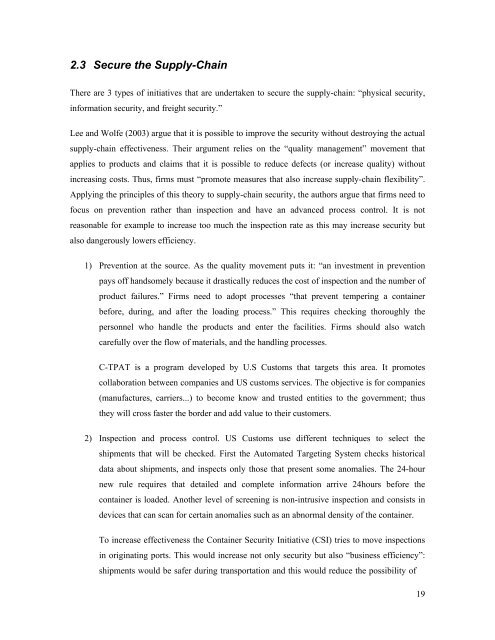Managing Risks of Supply-Chain Disruptions: Dual ... - CiteSeerX
Managing Risks of Supply-Chain Disruptions: Dual ... - CiteSeerX
Managing Risks of Supply-Chain Disruptions: Dual ... - CiteSeerX
You also want an ePaper? Increase the reach of your titles
YUMPU automatically turns print PDFs into web optimized ePapers that Google loves.
2.3 Secure the <strong>Supply</strong>-<strong>Chain</strong>There are 3 types <strong>of</strong> initiatives that are undertaken to secure the supply-chain: “physical security,information security, and freight security.”Lee and Wolfe (2003) argue that it is possible to improve the security without destroying the actualsupply-chain effectiveness. Their argument relies on the “quality management” movement thatapplies to products and claims that it is possible to reduce defects (or increase quality) withoutincreasing costs. Thus, firms must “promote measures that also increase supply-chain flexibility”.Applying the principles <strong>of</strong> this theory to supply-chain security, the authors argue that firms need t<strong>of</strong>ocus on prevention rather than inspection and have an advanced process control. It is notreasonable for example to increase too much the inspection rate as this may increase security butalso dangerously lowers efficiency.1) Prevention at the source. As the quality movement puts it: “an investment in preventionpays <strong>of</strong>f handsomely because it drastically reduces the cost <strong>of</strong> inspection and the number <strong>of</strong>product failures.” Firms need to adopt processes “that prevent tempering a containerbefore, during, and after the loading process.” This requires checking thoroughly thepersonnel who handle the products and enter the facilities. Firms should also watchcarefully over the flow <strong>of</strong> materials, and the handling processes.C-TPAT is a program developed by U.S Customs that targets this area. It promotescollaboration between companies and US customs services. The objective is for companies(manufactures, carriers...) to become know and trusted entities to the government; thusthey will cross faster the border and add value to their customers.2) Inspection and process control. US Customs use different techniques to select theshipments that will be checked. First the Automated Targeting System checks historicaldata about shipments, and inspects only those that present some anomalies. The 24-hournew rule requires that detailed and complete information arrive 24hours before thecontainer is loaded. Another level <strong>of</strong> screening is non-intrusive inspection and consists indevices that can scan for certain anomalies such as an abnormal density <strong>of</strong> the container.To increase effectiveness the Container Security Initiative (CSI) tries to move inspectionsin originating ports. This would increase not only security but also “business efficiency”:shipments would be safer during transportation and this would reduce the possibility <strong>of</strong>19
















